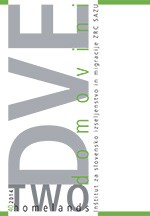“It’s All True!” The Use of the Biographical Method in Research on Šavrinkas
Keywords:
biographical method, women’s labour migration, Šavrinkas, IstriaAbstract
Grounded in ethnographic research on women’s labour migration between the hinterland and thecoastal towns of Istria in the first half of the 20th century, the text highlights the use of the biographical method. It presents the specific methodological approach used in the research on Šavrinkas, and the reasons for using this type of methodology, as well as the broader historical context of the use of biographical methods in anthropology. The intertwining of the research topic and methodology as well as the past and the present will be discussed. Both emphases are crucial for the understanding of undocumented or at best artistically interpreted lives of women egg-traders, as well as their echoes in thepresent, in which migrant women played a crucial role in the process of forming the heritage of the area.
Downloads
References
Anderson, Kathrin, Jack, Dana Crowley (1991). Learning to Listen: Interview Techniques and Analysis. Womens Worlds: The Feminist Practice of Oral History. New York, London: Routledge, 11–26.
Baskar, Bojan (2002a). Med regionalizacijo in nacionalizacijo: Iznajdba šavrinske identitete. Annales: Series historia et sociologia 12/1, 115–132.
Baskar, Bojan (2002b). Dvoumni Mediteran: Študije o regionalnem prekrivanju na vzhodnojadranskem območju. Koper: Zgodovinsko društvo za južno Primorsko, Znanstveno-raziskovalno središče Republike Slovenije.
Boas, Franz (1943). Recent Anthropology. Science 98, 334–337.
Brumen, Borut (1996). The State Want It So, and the Folk Cannot Do Anything Against the State Anyway. Narodna umjetnost 33/2, 139–155.
Brumen, Borut (2000). Sv. Peter in njegovi časi: Socialni spomini, časi in identitete v istrski vasi Sv. Peter. Ljubljana: Založba /*cf.
Buechler, Hans, Buechler, Judith-Maria (1996). The World of Sofia Velasquez: The Autobiography of a Bolivian Market Vendor. New York: Columbia University Press.
Burgos-Debray, Elizabeth (1984). Introduction. I, Rigoberta Menchú (ur. Elisabeth Burgos-Debray). New York: Verso, xi-xxi.
Crapanzano, Vincent (1980). Tuhami: Portrait of a Maroccan. Chicago: University of Chicago Press.
Driessen, Henk (1998). Introduction: Trends, Genres and Cases in Self-Revelation. Focaal 32, 7–13.
Dukovski, Darko (1997). Svi svjetovi istarski. Pula: C.A.S.H. Histria Croatica.
Franca, Marija (1990). Šavrinske zgodbe. Koper: Fontana.
Franca, Marija (1992). Šavrinske zgodbe 2. Koper: Fontana
Franca, Marija (1995). Šavrinske zgodbe 3. Koper: Fontana.
Hladnik, Milharčič Mirjam (2007). Avto/biografičnost v narativnosti: Metodološko teoretični pristopi v raziskovanju migracijskih izkušenj. Dve domovini / Two Homelands 26, 31–46.
Intervju 1. Intervju z Marijo Franca, 3. 12. 1994, Gračišče (intervju vodili Špela Ledinek Lozej, Nataša Rogelja).
Intervju 2. Intervju z Marijo Knez, 25. 8. 1999, Movraž (intervju vodili Špela Ledinek Lozej, Nataša Rogelja).
Kocjančič, Alojz (1962). Šavrinske pesmi. Ljubljana: Ciril-Metodijsko društvo katoliških duhovnikov LRS.
Orehovec, Martina (1997). Delo Istrank v Trstu. Etnolog 58/7, 115–129.
Langness, Lewis Leroy (1965). The Life History in Anthropological Science. Toronto: Holt, Rinehart and Winston.
Ledinek, Špela, Rogelja, Nataša (2000). Potepanja po poteh Šavrinke Marije. Ljubljana: Slovensko etnološko društvo.
Ledinek Lozej Špela, Rogelja, Nataša (2012). Šavrinka, Šavrini in Šavrinija v etnografiji in literaturi = The Šavrinka, Šavrin, and Šavrinija in Ethnography and Literature. Slavistična revija 60/3, 537–547, 549– 560.
Lewis, Oscar (1979). The Children of Sanchez. Harmondsworth: Penguin Books (orig. 1961).
Mihelj, Sabina (2006). Transformations of Imagined Landscapes: Istra and Šavrinija as Intercultural Naratives. History of the Literary Cultures of East-Central Europe: Junctures and Disjuncures in the 19th and 20th Cenuries (ur. Marcel Cornis-Pope, John Neubauer). Amsterdam, Philadelphia: John Benjamins publishing company, 364–373.
Mihurko Poniž, Katja (2011). Reprezentacije aleksandrink v prozi Marjana Tomšiča. Dve domovini / Two Homelands 34, 47–62.
Okely, Judith, Callaway, Helen (ur.) (1992). Anthropology and Autobiography. London: Routledge.
Radin, Paul (1926). Crushing Thunder: The Autobiography of an American Indian. New York: Appleton.
Ramšak, Mojca (2000). Zbiranje življenjskih zgodb v slovenski etnologiji. Etnolog 10, 29–41.
Rogelja, Nataša, Ledinek Lozej, Špela (1996). Šavrinka, Šavrini, Šavrinija. Glasnik Slovenskega etnološkega društva 36/2–3, 40.
Rogelja, Nataša, Ledinek Lozej, Špela (1997). Šavrinka kot oseba in simbol. Etnolog (Nova vrsta), 7/58, 131–145.
Rojac, Nadja (2005). Študijski krožki kulturnega društva Beseda slovenske Istre. Bogataj, Nevenka. Študijski krožki: Od zamisli do sadov v prvem desetletju (ur. Nevenka Bogataj). Ljubljana: Andragoški center Slovenije, 140–144.
Sharpe, Sue (1978). Just Like a Girl: How Girls Learned To Be Women. Hermondsworth: Penguin Books.
Sheller, Mimi (2011). Mobility. Sociopedia.isa. Drexel University.
Shostak, Marjorie (1981). Nisa, the Life and Words of a !Kung Woman. Cambridge, MA: Harvard University Press.
Stanley, Liz (1996). O avto/biografiji v sociologiji. Teorija in praksa 33/5, 764–774.
Tomšič, Marjan (1986). Šavrinke. Ljubljana: Kmečki glas.
Tomšič, Marjan (1993). Zrno od frmentona. Ljubljana: Cankarjeva založba.
Tomšič, Marjan (2000). Jože Pohlen – Istran in svetovljan. Fontana 31/32, 129–133.
Urbanc, Mimi (2012). Reprezentacije kulturne pokrajine v besedilih o slovenski Istri. Annales, Series historia et sociologia 22/1, 199–210.
Verzijbergen, Els (1998). »How on Earth Am I Supposed to Use This Underwear?« Listening To and Interpreting Life Stories. Focaal 32, 15–28.
Downloads
Published
How to Cite
Issue
Section
License

This work is licensed under a Creative Commons Attribution-NonCommercial-NoDerivatives 4.0 International License.
Authors guarantee that the work is their own original creation and does not infringe any statutory or common-law copyright or any proprietary right of any third party. In case of claims by third parties, authors commit their self to defend the interests of the publisher, and shall cover any potential costs.
More in: Submission chapter





